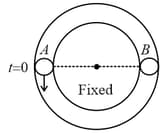Collisions
Collisions: Overview
This topic covers concepts, such as Head-on Inelastic Collision, Perfectly Inelastic Collision, Head-on and Oblique Collisions, Collisions, Expressions of Velocities after Elastic Collision, and Linear Momentum and Collisions.
Important Questions on Collisions
A small block of mass moves on a frictionless surface of an inclined plane, as shown in the figure. The angle of the incline suddenly changes from to at point B. The block is initially at rest at A. Assume that collisions between the block and incline are totally inelastic. . 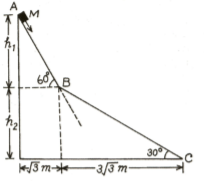
A block of mass is moving with a speed of on a smooth surface. It strikes another mass of and then they move together as a single body. The energy loss during the collision is:
Two small particles of equal masses start moving in opposite directions from a point in a horizontal circular orbit. Their tangential velocities are and , respectively, as shown in the figure. Between collisions, the particles move with constant speeds. After making how many collisions, other than that at , these two particles will again reach the point ?
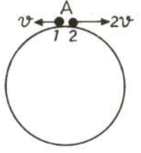
A smooth sphere is moving on a frictionless horizontal plane with angular speed and centre-of- mass velocity . It collides elastically and head-on with an identical sphere at rest. Neglect friction everywhere. After collision, their angular speeds are and respectively. Then:
Consider a rubber ball freely falling from a high height on to a horizontal elastic plate. Assume that the duration of collision is negligible and the collision with the plate is totally elastic. Then the velocity as a function of time and the height as a function of time will be:
Two particles of masses and , in projectile motions, have velocities respectively at . They collide at time . The velocities become and at time while moving in air. The value of is
A point mass of collides elastically with a stationary point mass of . After their collision, the mass reverses its direction and moves with a speed of . Which of the following statements is correct for a system of these two masses?
A body of mass is moving with speed makes a one-dimensional collision with a stationary body of the same mass on a horizontal table. They are in contact for a very small interval of time . The contact force between them varies as shown in the graph. (Neglect friction). The coefficient of restitution for the collision will be
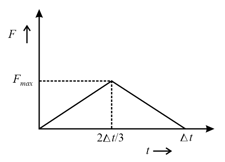
A charged particle moves towards another charged particle. Under what conditions the total momentum and the total energy of the system conserved?
Which is conserved in inelastic collision? Total energy (or) Kinetic energy?
A mass M moving with a certain speed V collides elastically with another stationary mass After the collision, the masses M and m move with speeds and respectively. All motion is in one dimension. Then,
Two point objects and each of mass and initially at rest are connected by massless threads as shown in the figure. A constant force acts on the system at point along . After the point has moved a distance in the direction of force, the two objects collide and stick together. The displacement and velocity of the centre of mass of the system immediately after collision are respectively
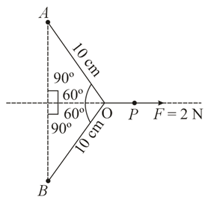
A ball of mass moving at speed makes a head-on collision with an identical ball at rest. The kinetic energy of the balls after the collision is three-fourth of the original. The coefficient of restitution is
Two particles having position vectors and at are moving with velocities and . For what value of they collide at
Block is hanging from a vertical spring and is at rest. Block strikes the block with velocity and sticks to it. Then the value of for which the spring just attains natural length is :-
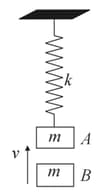
A neutron moving with a speed makes a head on collision with a stationary hydrogen atom in the ground state. The minimum kinetic energy of the neutron for which inelastic collision will take place in (closest to nearest integer) is:
A rod AB of mass M and length L is lying on a horizontal frictionless surface. A particle of mass m travelling along the surface hits the end A of the rod with a velocity v0 in a direction perpendicular to AB. The collision is completely elastic. After the collision the particle comes to rest.
A point P on the rod is at rest immediately after the collision. Find the distance AP.
For next two question please follow same
A rod AB of mass M and length L is lying on a horizontal frictionless surface. A particle of mass m travelling along the surface hits the end A of the rod with a velocity v0 in a direction perpendicular to AB. The collision is completely elastic. After the collision the particle comes to rest.
Find the ratio
For next two question please follow the same
Electrostatic force on a charged particle is given by . If q is positive and if q negative
In the figure mA = mB = 1 kg. Block A is neutral while qB = - 1C. Sizes of A and B are negligible. B is released from rest at a distance 1.8 m from A. Initially spring is neither compressed nor elongated.

If collision between and is perfectly inelastic, what is velocity of combined mass just after collision?
Particle moves with speed in a frictionless circular fixed horizontal pipe of radius and strikes with of double mass that of . Coefficient of restitution is known to be and particle starts its journey at . What will be the time at which second collision occurs?
